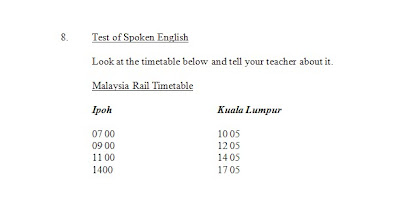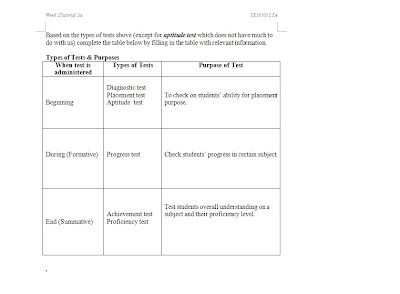Tesl : Language Testing and assessment. My e-portfolio
Translate
Friday, 14 December 2012
Criteria for Evaluating Language Tests
In terms of validity, the items in the question 1 are valid because it test about grammar, which reflect on what it supposed to measure. The distractors are able to do their job. Students might answer b or d. However, it is not practical because the item are hard to construct. Test makers need to make sure that there is only one answer for each question to avoid argument regarding the answer. Therefore, the items are not reliable since there are two possible answers for the questions. Students may get negative washback effect because of the confusion while choosing the right answer. Question 2 is not practical because the item is ambiguous. Students might have several different answer. The items is not valid because it doesn't have specific purpose on testing students' language ability. To answer this question will consumes time because it needs a lot of thinking while arranging the dialogue.
Question number 3, it has content validity because it is about grammar and it measure what it supposed to measure.
Question number 4 is valid in term of content validity because it measure what it proposed to measure (vocabulary). However, the questions are to difficult for students, it will gives negative washback effect. Students will takes time to answer the questions, therefore it is not practical.
Question number 5 is seen as valid, reliable, practical and have positive washback effect. It is valid because the question clearly test about listening skills. It's reliable because the question is unambiguous, each questions only have one answer. For practicability, the question is easy to construct and conduct, and it does not consumes time to answer it. Teacher can use this test to enhance students' listening skills which gives positive washback effect. Question 6 is not valid because it does not measure communicative competence but the test is about grammar. Therefore, it doesn't measure what it proposed to measure. Question 7 is practical and reliable, it is easy to construct and conduct. But rubrics should be provided as marking or scoring guideline. Question 8 is ambiguous because the instruction is not clear. Students may speak anything about the timetable and not about the time in Ipoh and Kuala Lumpur.
Which do you prefer - Holistic or Analytic marking?
MY RESPONSE:
For me, I prefer to use Analytic marking because lack of experience in marking. Using holistic marking needs teacher to mark the test as a whole. It requires teacher's experience in giving marks. Meanwhile, analytic marking can be used by referring to specific rubric or test specification. Therefore, as soon-to-be teacher, I prefer using analytic marking or scoring to gain the experience. :)
Wednesday, 12 December 2012
Monday, 12 November 2012
Comprehensive assessment
|
Thoughts on Youtube video watched
|
|
|
|
Give your thoughts on what was significant to
you in the assessment used. TQ
|
Re: Thoughts on Youtube video watched
This is my new feedback on the
Youtube video because the old one is missing.
Basically the video is about
comprehensive assessment. It shows that alternative methods in testing and
teaching are more suitable for 21st century learner. Traditional and
alternative method are different. Traditional method use exam-oriented to test
the students, while alternative method such as project based learning test on
what students know and what they able to do by doing it practically. After all
traditional method in testing is quite stressful because often
students need to memorize in order to answer the examination's paper. It maybe
good for students that have the ability to memorize easily, but it is not fair
for other students. However, I think that traditional method and alternative
method can compliment each other to build students' integrated skills. 
pa� g < s �� `� /span> | Edit | Delete | Reply
Subscribe to:
Comments (Atom)










